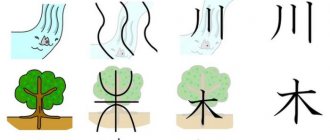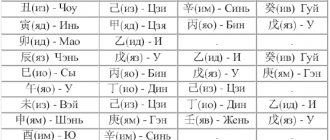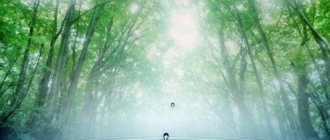Pentagram of the elements.
Elements, elements
- in magic: the four primary elements (Fire, Water, Air and Earth), understood as the four kingdoms, or divisions, of the natural world. The fifth element, Spirit, binds together and controls the four natural elements, which is graphically represented in the symbol of the pentagram. The elements are also considered as parts of nature or human nature, which are symbolically related to these elements in their properties - depth, lightness, fervor, hardness, and so on.
Elements or elements correspond to elemental or elemental weapons: Rod of Fire, Chalice of Water, Dagger of Air and Pentacle of Earth. In Golden Dawn ceremonies, symbols of the four elements are placed on the altar: a lamp (Fire), a cup of wine (Water), a rose or incense (Air), and a dish of bread and salt (Earth).
Eurostandard[edit]
In European culture there are four elements: earth, water, fire and air. Everything that exists consists of them, and various properties are manifested in them: earth, for example, is hard, motionless and inflexible, and water is unsteady and flowing, therefore, everything that is hard and inflexible can be considered belonging to the element of earth, and everything that is unsteady and fluid - the elements of water. Sometimes they also add a certain fifth element, called “quintessence” or “ether,” which is intended to symbolize souls, spirits or pure energy. There was a very similar system of elements in Japan, only instead of ether there was emptiness. In other systems, the fifth element (or, as more often translated, the fifth element) was considered the philosopher's stone.
By a strange coincidence, the four aggregate states of matter (solid, liquid, gas, plasma) and the four shells of the Earth (lithosphere, hydrosphere, atmosphere, magnetosphere) can easily be put in correspondence with the four elements.
Images and motifs associated with Western elements[edit]
- Earth: Stable and unyielding, earth is the element of firmness and support. It is usually the strongest, but slowest of the elements. Characters associated with the earth are strong and calm, you can always rely on them. The image of the fertile mother earth also leads to the association of this element with motherhood. The negative side of these characters is stubbornness, old-fashionedness and reluctance to change. Often this element is also associated with plants, which successfully compensates for its main shortcomings.
- Fire: The most ambiguous of the elements, on the one hand, it is warm, light, cleanses and regenerates, on the other hand, it is the most aggressive of the elements, wild, destructive and unpredictable. Characters associated with fire are impulsive, harsh and hot choleric people.
- Air: The element of winds and changes, sometimes calm, sometimes hurricane. Generally considered to be the weakest but fastest of the elements. Characters associated with air are cheerful, energetic, and free.
- Water: The element of fluidity and adaptation, taking any form. It is also usually a very positive element, symbolizing calmness and healing. If the earth is strong but slow, and the air is weak but fast, then the water is both strong and fast, but not to the same extent as either one. Characters associated with water are usually calm, relaxed, non-conflicting, and easily agree with others (although they still do things their own way).
Antiquity
In antiquity, a paired primary quality (stoicheia) of activity and passivity was distinguished from which the active principles “dry” and “wet” and the passive principles “cold” and “warm” emanate. From their combinations the actual elements are formed: “dry” and “cold” form earth, “dry” and “warm” - fire, “wet” and “warm” - air, “wet” and “cold” - water.
Primary qualities - active passive Origins - dry - wet cold - earth - air warm - fire - water
In Greco-Roman symbolism, the elements are usually personified by female figures or deities, and from these bases come numerous series of analogies. Gods - Animals - Objects - Season - Liquor - Organ - Color - Temperament - Body (geometric)
Water - Neptune - Nereids, dolphin, horse - overturned or leaking vase - winter - bodily mucus - brain - white color - phlegmatic - icosahedron - triangle
Fire - Vulcan - woman whose head is on fire, phoenix - summer - (yellow) bile - liver - fiery colors - choleric - tetrahedron
Earth - fertility goddesses - tower-crowned head of Cybele, chthonic snake, scorpio - cornucopia - autumn - black bile - spleen - lead color - melancholic - cube - square
Air - Juno and the peacock, Juno flying, with bellows suspended from her feet - peacock, chameleon (thought to feed on air) - spring - blood - heart - bright colors - sanguine -
Ancient theories of healing, which have survived in whole or in part to the present day, proclaimed as the main goal of healing the harmonization of these components in a person, so that none of them received absolute superiority, damaging their optimal balance. A curious thing is the symbolic comparison of the “four elements” with geometric solids in Plato’s dialogue “Timaeus”, which says:
“We, of course, attribute to the earth the form of a cube: after all, of all four genera, it is the earth that is most motionless and suitable for the formation of bodies, and therefore it is necessary for it to have the most stable bases... the least mobile [triangle taken as the base]... we will assign to water (icosahedron), . the most mobile one is for fire (tetrahedron), and the middle one is for air, and finally, the most acute-angled body is for fire, the next one is for air, and the third is for water.” Plato, Timaeus, 55e-56a.
The dodecahedron symbolizes the Universe.
Chinese[edit]
In China the situation was slightly different. There are five elements: fire, water, earth, wood and metal. The tree also includes various plant life, which in the European tradition is usually classified as Earth. The five elements can stand in a circle: wood => fire => earth => metal => water => wood, forming a Chinese version of the pentagram (not used, unlike the European version, to summon spirits), where the circle illustrates the generation of the elements (water generates a tree, a tree generates fire, etc.), and a star – overcomes (metal overcomes a tree, a tree overcomes the earth, etc.). The elements can also stand in the cardinal directions: fire - south, water - north, wood - east, metal - west, earth - center. In addition to the pentagram, the 5 elements can be displayed together as a Chinese red plum flower, which has just 5 petals.
In addition, the 5 elements form a 10-year cycle. It is less known to us than the Chinese “horoscope” of 12 animals, but in the same horoscope this cycle is manifested in adjectives and epithets, for example, “year of the Black Snake.” In this cycle, each element lasts two years (yin and yang, ascension and decline) and gives its properties to the current animal of the Chinese calendar. So, for example, 2013 the Year of the Snake belongs to the element of water, and the Snake, accordingly, is black (since water corresponds to black, and blue is considered the color of wood [1]).
Each element also has its own color, its own animal and many other attributes:
- Water is identified with black, gray or blue colors. Her animal is the Snake-Turtle (contrary to the name, this is not a hybrid, but two separate animals - the snake is entangled around the turtle. The positive emotion of Water is calm, and the negative emotion is fear.
- Fire - red color, Crimson Bird, joy and hate.
- Metal - white, White Tiger, courage and sorrow.
- Tree - green and blue, Azure Dragon, optimism and anger.
- Earth - yellow, Yellow Dragon/Qilin, empathy and anxiety.
Alchemy
According to alchemists, the occult elements, symbolized by the triangle, are qualities of a single substance,” supersensible abstractions that are opposed in pairs: Fire-Water, Air-Earth. In the generalized picture of the world of alchemy, the greatest attention is paid to the dualistic system of the paired principles of sulfur and mercury (sulfur and mercury, respectively). It is believed that by manipulating the constituents in a mixture of these elements in certain proportions to a simultaneous state of fix (solid) and volatil (fluid), the sun-like appearance of gold is achieved. As the third component of these "philosophical elements" Paracelsus (1493-1541) included sal (salt) in order to achieve obvious tangibility (fit for consumption). For a person who thinks in alchemical categories, 4 elements form a cross, which is also a world square. This figure can be formed by two pairs of basic states: hot and dry - cold and wet. The fire is just hot and dry, the water is cold and wet. Between them are elements that are not so opposed to each other: earth == dry and cold, air == hot and humid.
Various fantasy (sic!) elements[edit]
Elements of Heroes of Might and Magic IV in the pentagram
But the limits of elemental myth-making do not end there. In the elements, you can write down any natural or not so natural force or phenomenon. Often there are “elements” Light and Darkness, less often - various pseudo-scientific ones, such as Magnetism, Time, Space, Gravity, Acid, or parodies, for example, Pizza. In D&D, in addition to the classic four elements and five magical destructive elements, there are various para-elements and quasi-elements, which are mixtures of elements with each other, with positive and negative energy, such as, for example, Dust, Radiation, Magma, Vacuum and others. In parody works, an element can be equated with a chemical element, which are equally called element in English: for example, in the web comic Order of the Stick there are elementals made of titanium and chlorine. There are also D&D quasi-elemental elements in the form of the Marshmallow Plane and the Semi-elemental Plane of Ranch Sauce.
In Heroes of Might and Magic IV, the five magical elements (life-order-death-chaos-nature) were placed in the corners of the pentagram, and Force was placed in the center - so, for example, the elements of Nature are friendly to the elements of Life and Chaos, and hostile to the elements of Death and Order.
In the restart of Might and Magic, that is, in all games where the action takes place in the world of Ashan (starting with Heroes of Might and Magic V, where the system was not yet fully established), there are six elements: light, darkness, fire, water, air, earth . Each element is associated with a minor dragon god (Elemental dragons), which, in turn, are associated with the original intelligent races of Ashan (each dragon has a race, however, over the course of the history of the world, everything has become somewhat mixed up). Above the elements are two forces, Order and Chaos, again represented by two dragons, and all the elements are derivatives of Order, like the younger dragons - the children of the dragoness of Order Asha, the creator of the world. Local magic has schools of all six elements, and there is also some primordial magic associated with Order, Chaos and Primordial Emptiness. In general, it turned out smoothly.
In general, in the original RPG Might and Magic (from which, by the way, those “Heroes” we all love originated) there were 9 main schools of magic: 4 elemental schools of Elements - Fire, Earth, Water and Air; 3 “humanitarian”/healing schools of Ego - Body, Mind and Spirit; 2 mirror Light and Dark. All the rest are minor-tertiary derivatives of this nine.
In the Disciples series, the elements are: water, air, earth, fire, death, life, mind. Some strategic spells are not included in any element.
And the creators of “Lego: Ninjago” decided to put the pedal to the metal and gave out the following elements: fire, ice, lightning, earth (four main ones), water, wind, shape, gravity, speed, nature, poison, sound, smoke, shadow, light , metal, time, mind and amber (or rather, the absorption of other forces).
Although, compared to the psychedelic model of the “OFF” world, even the variety of ninjaga pales: the four elements here are represented by metal, smoke, plastic and meat. Metal is the most important element of the four, because without it people would have nothing to walk on, and then they would drown and die. Smoke is the most important element of the four, because without it people would have nothing to breathe, and then they would suffocate and die. Plastic is the most important element of the four, because the ocean of liquid plastic limits the world, and without it people would wander endlessly and die of fatigue. Meat is the most important element of the four, because without it there would be nothing to eat, and people would die of hunger. The metal is mined from the carcasses of cows that graze the grass above the metal deposits. Smoke is dug out from the depths of the earth in deep mines. Plastic is scooped up from a bottomless plastic ocean. The meat is drawn from meat rivers. In the world of the game, the secret fifth element is also separately designated - sugar, extracted from human corpses, and which is a powerful drug.
Elemental Correspondences
Modern Western magicians David Rankine and Sorita d'Este provide in their book “Practical Magic of the Elements” [1] the following table of correspondences of magical intentions and elements, which may be useful to you in practical work.
Table of Magical Intentions
| Intention | Elements |
| Astral travel | Water |
| Unconscious (find access) | Water |
| Business (achieve prosperity) | Air |
| Welfare (increase) | Fire; Earth |
| Future (find out) | Air, Water |
| Influence (increase) | Air |
| Lust (satisfy) | Earth; Fire |
| healing | Fire, Air |
| Public speaking (successful) | Air |
| Harmony (develop) | Fire, Air |
| Flexibility (develop) | Air |
| Anger (control) | Fire |
| Money (purchase) | Fire |
| Duty (fulfill) | Earth |
| Home (protect) | Earth |
| Friendship (develop) | Earth |
| Law (relations with) | Air; Earth |
| Health (strengthen) | Air |
| Knowledge (increase) | Air |
| Illusions (induce) | Water |
| Illusions (dispel) | Earth |
| Property (return lost) | Air |
| Career | Fire, Air |
| Beauty (develop) | Earth |
| Leadership abilities (develop) | Fire |
| Love (to gain or strengthen) | Earth; Water |
| World (install) | Fire; Air |
| Musical abilities (acquired or developed) | Air |
| Communication skills (develop) | Earth; Air |
| Charm (purchase) | Water |
| Communication (facilitate) | Air |
| Responsibility (accept) | Air; Water |
| Memory (improve) | Air |
| Fertility (purchase) | Earth |
| Promotion (get) | Fire; Air |
| Patronage (purchase) | Fire |
| Honors (to achieve) | Air |
| Truth (to find out or report) | Air |
| Practicality (develop) | Earth |
| Teaching abilities (develop) | Earth; Air |
| Attractiveness (enhance) | Earth |
| Travel (safe) | Air (by air), Water (by sea), Land (by land) |
| Equilibrium (set) | Earth |
| Discord (cause) | Fire |
| Discord (prevent) | Air |
| Childbirth (safe) | Water |
| Sexual desire (weaken) | Earth |
| Sexual desire (increase) | Fire |
| Strength (develop) | Fire; Earth |
| Willpower (strengthen) | Fire |
| Dreams (induce and remember) | Water, Air |
| Passion (ignite) | Fire; Earth |
| Fear (eliminate) | Fire |
| Creative abilities (develop) | Fire, Air |
| Patience (develop) | Earth |
| Self-confidence (acquire) | Earth |
| Self-confidence (strengthen) | Earth |
| Luck (purchase) | Air |
| Pleasure (get) | Earth |
| Courage (develop) | Fire |
| Determination (develop) | Fire, Air |
| Sense of humor (develop) | Air |
| Exams (successfully pass) | Air |
| Energy (develop) | Fire |
| Energy (accumulate) | Fire |
| Enthusiasm (cause) | Fire |
| Ethical principles (develop) | Air |
| clairvoyance (develop) | Water |
Of course, this table of correspondences is quite arbitrary and some correspondences may vary from tradition to tradition, from school to school.
Elementals[edit]
Elementals are creatures made of pure elements. The idea of them arose in the European magical tradition: the first standard of elementals was described by the alchemist Paracelsus. According to him, there are fire elementals (salamanders), air elementals (sylphs), water elementals (undines) and earth elementals (gnomes). The names that Paracelsus gave to the elementals are now rarely encountered, but these creatures themselves are very common. A variant is present in the Elder Scrolls universe, where elementals belong to the three destructive elements, are ownerless Daedra and are called atronachs.
In Dungeons & Dragons, the elements are Djinn (air), Ifrit (fire), and Marid (water). But since this is where the list of traditional genies ended (since in Arab mythology the descendants of Adam and Howa (Eve) are traditionally referred to as earth, as created from clay), we had to additionally invent the Jinns of the Earth - Tao[2], and the Jinns of the Ether - Dzhannov.
In China, 5 elements correspond to their animals (although not called elementals):
- Tree - azure (blue-green) Dragon
- Metal - white tiger
- Water - black turtle
- Fire - Red Phoenix
- Earth - yellow Unicorn (Qilin)
Astronomy/logy
Natural phenomena became the basis of the occult sciences, especially astrology, which divides the signs of the zodiac into four elements: Fire, a symbol of instinctive and subconscious biological dynamism: Aries, Leo, Sagittarius. Air, the tendency of the conscious to impressions: Gemini, Libra, Aquarius. Earth, activities aimed at implementation, the wealth of the human subconscious: Taurus, Virgo, Capricorn. Water, passivity and receptivity: Cancer, Scorpio, Pisces.
Elemental superpowers[edit]
Controlling the elements through magic, psionics, or simply inexplicable mutant powers is a classic superpower. Typically, one character has access to only one element in which he specializes and which is reflected in his personality. A specialist in fire, for example, not only knows how to use it well: he is fire himself, and fully corresponds to the description of the fire character given above, so other elements simply will not work out for him or will work out poorly.
See for example:
"I Circle"[edit]
Elementalism. Here are the original elements and their derivatives:
1. Main notebook…
- Playing with Fire Walking Crematorium
- Hellfire
- Cold flame
- Weather magic
- Ice Soul
- Lord of Metal
2. Fifth element/Fifth element. Something that goes beyond the tetrad. Sometimes associated with an aspect of the Universe itself
- Ether
- Void Singularity
- Shock and Awe Electric Psycho
"II circle"[edit]
Existentialism. Hexiad of elements, but more subtle ones - life-death, etc. No derivatives are observed:
- Dark energy vs. As soon as I light it up (Power of the Sun)
- Biomagic vs. Decay and decay/Death/Necromancy.
- The Power of Entropy
- Creation/Summoning and Matter Magic vs Magic Disintegration
- Theurgy/Theology vs Demonology
"III circle"[edit]
Structuralism. Near-scientific physical and chemical disciplines:
- Kinetics
- Time Master and Topologist Sorcerer
- Artefacts and Technomagic
- Radiation is magic!
- Math is magic
Occultism
Natural phenomena became the basis of the occult sciences, especially astrology, which divides the signs of the zodiac into four elements: In the works of the Rosicrucians one can find the doctrine of the secrets of the four kingdoms, especially known, at least to modern occultists, are the works of Count Cabali (under this pseudonym), filled with Gallic humor. the name of a real-life wise knight from eastern Germany or even Hungary is hidden). Let us think about the fact that without the myths collected by alchemists, followers of Paracelsus and Rosicrucians, the work of the romantics would have been impossible in general - they populated their poetry, music and painting with the spirits of nature with whom their heroes met. Thus, they brought back to life the tales and information collected in popular beliefs.
Anti-Element[edit]
The creators of the little-known duology “The Chronicles of Tarr” (it is little known, mainly because of the undeveloped gameplay - which is very sad, because the universe of this duology is very attractive) came up with the role of the absolute threat of Darkness - something completely alien, opposite and at the same time preceding everything and that's it. Darkness is called Anti-Element for the reason that if the elements are anything at all, then Darkness is simply nothing, and in itself it literally does not exist. With all this, the Darkness changes everything it comes into contact with - matter and energy become incomprehensible, time and space go crazy (everything in the Darkness is immobilized), light sources begin to absorb light, and the living turn into restless “non-creatures” and a lot more fun . Although they have somehow learned to fight the Darkness, this fight is based on a pure reluctance to waste it like that, because it is impossible to win in it - there is simply nothing to win.
In World of Darkness there are four anti-elements of the Serpent (the local Dragon of the Apocalypse and the Serpent of Chaos in one bottle): hellfire (anti-fire), toxins (anti-water), slag (anti-earth) and smog (anti-air). Primitive magic based on them is used by line sorcerers of the Seventh Generation. And Nephandi (dynamic magicians in the service of the Serpent) actively use anti-Spheres.
In Dungeons & Dragons there are so-called similar structures. “negative quasi-elements”: ash (negative fire), dust (negative earth), salt (negative water) and vacuum (negative air). They are all a mixture of normal elements with negative energy that represents the absence of life and animates the undead. Besides them, which is typical, there are also positive ones
quasi-elements - lightning (positive air), minerals (positive earth), steam (positive water) and radiation (positive fire).
(Somewhere else I came across either a book or something like that, where each element had its own anti-element with its own anti-elemental, but they were simply terribly rare. If anyone remembers, please add.)
Emblematics
In Western art: water was depicted as an overturned jug or figures of the gods of the sea and rivers; air - the figure of Juno, sometimes flying with shackles on her hands and feet, sometimes a woman with a chameleon in her hand; fire - the Phoenix, the figure of Vulcan, as well as a woman with fiery hair or lightning in her hand; the earth - an allegorical figure of the Mother with symbols of fertility in her hands; as well as the tower-shaped crown of Cybele. The four elements can be represented either as conventional faceless female figures, distinguishable only by their attributes, or, especially in the 16th century, as the gods and goddesses of classical antiquity. They can be found on the frescoes and ceilings of Renaissance buildings in Italy, and also as individual paintings that make up a four-part cycle, although they are often scattered across different galleries. Northern European genre artists and authors of files galantes of the 17th-18th centuries gave the names of these four elements to cycles of paintings depicting young men and women engaged in some corresponding activity. The Earth, like a woman, has many attributes belonging to the goddesses of fertility: the horn of plenty and the SERPENT, SCORPIO of the Roman goddess of agriculture, the Earth-Mother (Latin - Tellus Mater). She can breastfeed one or two children, like Ops, the Roman goddess of the harvest. The crown in the form of a wall with turrets was taken from CYBEL - the ancient Phrygian Earth-Mother. Genre scenes depict various agricultural works - picking fruits, plowing the ground, watering the beds, and so on. Air was the kingdom of Juno, and therefore it can be represented by this goddess with her PEACOCK. Or she is depicted floating in the air, with an anvil tied to each of her legs - this is how Jupiter punished his wife for disobedience (Iliad, 15:18-21). She may be surrounded by BIRDS - a symbol of air. Air is personified by a woman holding a CHAMELEON - a creature that, according to Pliny (Natural History, 8:33), does not eat or drink, but lives on air. Boys and girls of the 18th century are depicted outdoors playing with toy windmills or blowing soap bubbles. Fire. Takes the form of a woman with her head on fire, she holds a BEACH OF LIGHTNING. Or on her head instead of a hairstyle is a Phoenix bird, engulfed in fire, which is her symbol. VULCAN, that smith of the gods, with hammer in hand, likewise personifies fire. He can be depicted at work - forging the armor of Aeneas, while Venus and Cupid watch him. Water is personified by the river god with his traditional attribute - an inverted URN from which water flows, or by NEPTUNE and his many companions - NEWTS and NEREIDS, accompanied by DOLPHINS, HIPPOCAMPS and sea centaurs. They appear with this meaning in many paintings with a marine theme. Genre artists depict fishermen sitting on the bank of a river or in a boat. See also FOUR TEMPERAMENTS.









